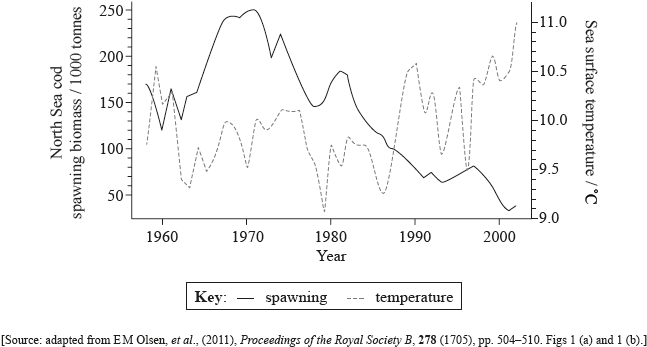| Date | November 2013 | Marks available | 1 | Reference code | 13N.3.HL.TZ0.10 |
| Level | Higher level | Paper | Paper 3 | Time zone | TZ0 |
| Command term | Suggest | Question number | 10 | Adapted from | N/A |
Question
Reproduction in fish is called spawning. The males and females in a population that are mature enough to reproduce are the spawning stock. In order to provide better fisheries management and conservation decisions, there is a need to investigate the relationship between spawning stock and environmental conditions. The graph shows the North Sea cod spawning biomass and sea surface temperatures.

State the sea surface temperature when the North Sea cod spawning biomass was the highest, giving the units.
State the North Sea cod spawning biomass when the sea surface temperature was the lowest, giving the units.
Outline the trends in North Sea cod spawning biomass between 1960 and 2000.
Evaluate the evidence provided by the data, for the prediction that North Sea cod will become extinct if sea temperatures continue to rise.
Suggest one factor, other than sea surface temperature, that might influence the North Sea Cod spawning
Markscheme
9.85 °C (accept answers in the range of 9.75 °C to 9.95 °C units required)
152 000 tonnes } (accept answers in the range of 150 000 tonnes to 155 000 tonnes units required)
(rapid) increase between 1960 and 1970;
decrease from 1970 to beyond 2000/2002:
brief reversal/slight increase between 1981 and 1982;
Evidence supporting the prediction
biomass trend declines as temperature trend increases / negative correlation from mid-’80s;
Evidence not supporting the prediction
no correlation between (finer) fluctuations in sea temperature and biomass between 1960 and mid-’80s;
peaks in sea temperature in 1960, 1990 and 2000 at same level with different biomass;
dip in both curves at the end of ’70s;
significance hard to demonstrate without statistical tools/OWTTE;
overfishing / predation / availability of the food / pollution / disease
Mark only the first answer if more than one provided
Examiners report
Most figured out the correct answer, but many were slightly out of range (10 °C). Spawning biomass was a different story: many were out of range and many also read the units incorrectly (e.g. 150/1000 tonnes instead of 150000 tonnes). Although most gained marks, outlining the trends was difficult for many, and evaluating the evidence for possible extinction was worse. For both questions, candidates had difficulty to relate to the time line; many were using the temperature (dependent variable) as a reference instead of the years (independent variable). Factors influencing the spawning biomass seemed random, some getting the correct answer.
Most figured out the correct answer, but many were slightly out of range (10 °C). Spawning biomass was a different story: many were out of range and many also read the units incorrectly (e.g. 150/1000 tonnes instead of 150000 tonnes). Although most gained marks, outlining the trends was difficult for many, and evaluating the evidence for possible extinction was worse. For both questions, candidates had difficulty to relate to the time line; many were using the temperature (dependent variable) as a reference instead of the years (independent variable). Factors influencing the spawning biomass seemed random, some getting the correct answer.
Most figured out the correct answer, but many were slightly out of range (10 °C). Spawning biomass was a different story: many were out of range and many also read the units incorrectly (e.g. 150/1000 tonnes instead of 150000 tonnes). Although most gained marks, outlining the trends was difficult for many, and evaluating the evidence for possible extinction was worse. For both questions, candidates had difficulty to relate to the time line; many were using the temperature (dependent variable) as a reference instead of the years (independent variable). Factors influencing the spawning biomass seemed random, some getting the correct answer.
Most figured out the correct answer, but many were slightly out of range (10 °C). Spawning biomass was a different story: many were out of range and many also read the units incorrectly (e.g. 150/1000 tonnes instead of 150000 tonnes). Although most gained marks, outlining the trends was difficult for many, and evaluating the evidence for possible extinction was worse. For both questions, candidates had difficulty to relate to the time line; many were using the temperature (dependent variable) as a reference instead of the years (independent variable). Factors influencing the spawning biomass seemed random, some getting the correct answer.
Most figured out the correct answer, but many were slightly out of range (10 °C). Spawning biomass was a different story: many were out of range and many also read the units incorrectly (e.g. 150/1000 tonnes instead of 150000 tonnes). Although most gained marks, outlining the trends was difficult for many, and evaluating the evidence for possible extinction was worse. For both questions, candidates had difficulty to relate to the time line; many were using the temperature (dependent variable) as a reference instead of the years (independent variable). Factors influencing the spawning biomass seemed random, some getting the correct answer.

